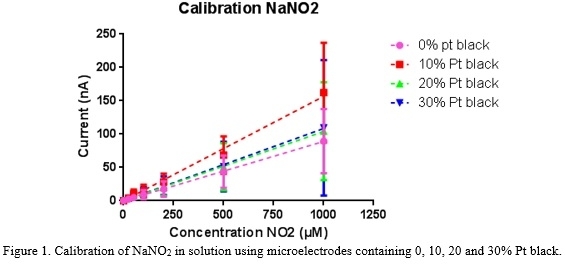Bladder conditions affect up to a third of adults over 65, hence the urinary bladder is highly susceptible to ageing1. In the bladder, the urothelium is an important barrier that has been shown to be a key regulator of bladder function2. It is thought that alterations in urothelial signalling could cause age-related functional changes in the bladder1,2. Nitric oxide (NO) is one of the key signalling molecules within the urothelium, which is significantly difficult to measure3,4. This measurement is complex due to the rapid reaction of NO with a wide range of biomolecules and its very short half-life5. Therefore, this study is focused on the development of novel sensing tools which have the suitability for measuring NO production from the bladder urothelium in order to understand changes that occur with ageing. Microelectrodes with electrochemical detection techniques have the required temporal and spatial resolution for monitoring NO production and metabolites such as nitrite in biological systems5. Varying compositions of conductive carbon composite microelectrodes containing 15% Multi Walled Carbon Nanotubes (MWCNTs) with varying quantities of Platinum black (0, 10, 20 and 30%) were fabricated. These sensors were tested for the measurement of different concentrations of nitrite (NO2-) using amperometry (Fig. 1). Comparing their performance, the sensitivity data revealed that for the detection of nitrite the most appropriate sensor was that containing 10% Pt black, with it being 8.898×10-11±8.112×10-12 A/μM for 0% Pt black, 1.775×10-10±8.732×10-12 A/μM for 10% Pt black, 1.039×10-10±1.034×10-11 A/μM for 20% Pt black, and 1.084×10-10±1.366×10-11 A/μM for 30% Pt black (Fig. 1). The same procedure will be followed for the detection and measurement of NO in solution, in order to determine the required composition for microelectrodes to detect nitrergic signalling from bladder tissue in situ. Measurements of young (3 months) and aged (24 months) bladder tissue will be performed using the electrodes containing the best composition for the detection of nitrergic species released by the urothelium. From the first studies conducted, the data proves that these sensors can detect both molecules in solution. The next steps in this study will investigate whether ageing causes any changes in nitrergic signalling in the bladder, which could lead to new therapies for patients suffering from bladder conditions.
Future Physiology 2019 (Liverpool, UK) (2019) Proc Physiol Soc 45, PC32
Poster Communications: Development of sensor for determination of NO production from bladder urothelium to understand changes with ageing
A. Tendero Cañadas1, B. A. Patel1
1. School of Pharmacy and Biomolecular Sciences, University of Brighton, Brighton, United Kingdom.
View other abstracts by:
Where applicable, experiments conform with Society ethical requirements.

